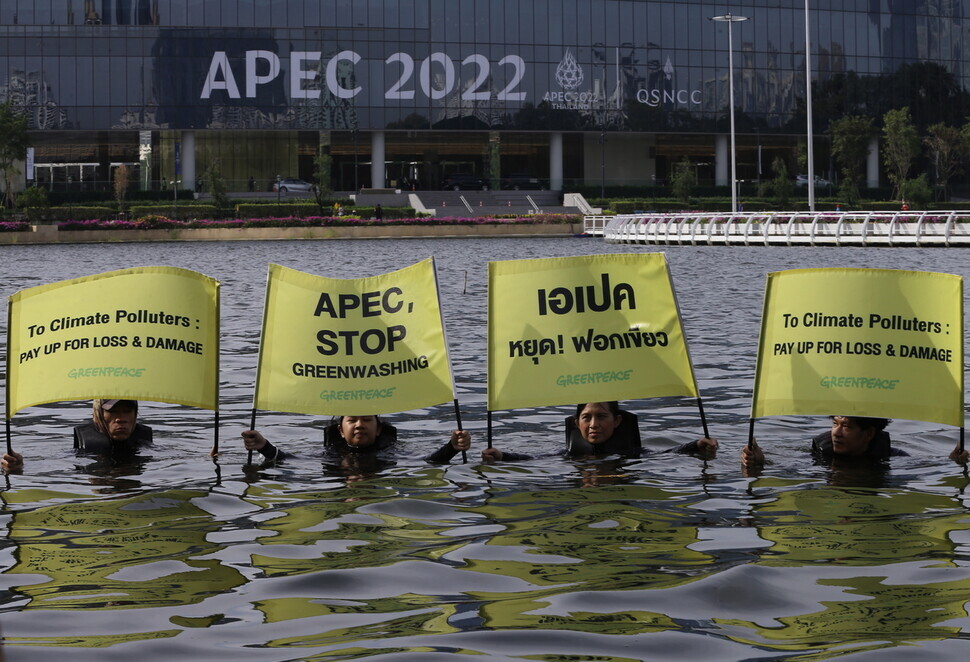hankyoreh
Links to other country sites 다른 나라 사이트 링크
With 0.4 degrees left until “red line,” are we doing the best we can on climate change?

Will humankind overcome this unprecedented climate crisis? Representatives from around the world gathered in the Egyptian resort town of Sharm El-Sheikh from Nov. 6-18 for the 27th United Nations Climate Change Conference (COP 27) to discuss countermeasures, but the future seems grim.
This year’s weather has been more than unusual. Europe and Australia suffered from bizarre heat waves, drought and wildfires. Many were killed in unexpected heavy rains in Nigeria and Pakistan. Recent reports have also announced that from 2011 to 2020, 90% of US counties went through floods, hurricanes, and wildfires so serious that they could be declared disaster areas by the federal government.
A few weeks ago, when the conference was coming to a close, research results were published that showed this gloomy reality in figures. According to a report released by the Global Carbon Project, an organization that quantifies global greenhouse gas emissions, the world’s emissions for 2022 are expected to increase by 1% in comparison to last year.
At this rate, global temperature will surpass the critical threshold of 1.5 degrees Celsius of global warming (compared to 150 years ago) in the early 2030s. When carbon emissions increased by 5.6% last year, there was room for comfort by saying that it was due to the base effect of reduced emissions because of the COVID-19 pandemic.
Should we attribute this year’s surge to the fact that many countries, after Russia’s sudden invasion of Ukraine, became concerned about energy shortages and therefore increased their consumption of fossil fuels with high carbon emissions, such as coal?
Questions about whether keeping global temperatures from rising by 1.5 degrees Celsius was feasible were raised in this year’s general meeting. The 2015 Paris Agreement does not make it clear if the 1.5-degree rise is an absolute figure that should be guarded at all costs.
The Paris Agreement stipulates that the increase in global temperatures should be kept below 2 degrees Celsius, and that measures should be taken to ensure that it does not exceed 1.5 degrees Celsius.
Global average temperatures have already risen 1.1 degrees Celsius compared to 150 years ago. There isn’t a lot of time left until it reaches 1.5 degrees. In order to meet this goal, extreme efforts should be made, such as halving carbon emissions from fossil fuels by 2030. If the goal is eased to 2 degrees rather than 1.5 degrees, there is less pressure to cut down on fossil fuels.
A 0.5-degree difference may not look like much, so some may think it might be wise to focus on the 2-degree goal, but experts think differently. They state that the scale and frequency of natural disasters such as heatwaves, floods and droughts will become much more severe.
The news is not just depressing. Luiz Inacio Lula da Silva, who recently won the Brazilian presidential election, attended this general meeting, and received applause for his announcement that he would actively protect the Amazon. It is expected that reckless logging and forest damage, which was allowed under predecessor President Jair Bolsonaro, will be put on hold.
The US and several countries in Europe also reaffirmed their willingness to reduce carbon emissions, saying that they will try to keep the threshold of 1.5 degrees Celsius. Some predict that many countries, which have become more aware of the importance of energy security due to Russia’s invasion of Ukraine, will invest more in low-carbon energy.
Abnormal weather syndromes have already become part of our reality, and they are getting worse. Reducing carbon emissions is not a choice, but a matter of survival. Are we doing the best that we can?
By Park Byong-su, senior staff writer
Please direct questions or comments to [english@hani.co.kr]

Editorial・opinion
![[Editorial] Intensifying US-China rivalry means Seoul must address uncertainty with Beijing sooner than later [Editorial] Intensifying US-China rivalry means Seoul must address uncertainty with Beijing sooner than later](https://flexible.img.hani.co.kr/flexible/normal/500/300/imgdb/original/2024/0517/8117159322045222.jpg) [Editorial] Intensifying US-China rivalry means Seoul must address uncertainty with Beijing sooner than later
[Editorial] Intensifying US-China rivalry means Seoul must address uncertainty with Beijing sooner than later![[Column] When ‘fairness’ means hate and violence [Column] When ‘fairness’ means hate and violence](https://flexible.img.hani.co.kr/flexible/normal/500/300/imgdb/original/2024/0516/7417158465908824.jpg) [Column] When ‘fairness’ means hate and violence
[Column] When ‘fairness’ means hate and violence- [Editorial] Yoon must stop abusing authority to shield himself from investigation
- [Column] US troop withdrawal from Korea could be the Acheson Line all over
- [Column] How to win back readers who’ve turned to YouTube for news
- [Column] Welcome to the president’s pity party
- [Editorial] Korea must respond firmly to Japan’s attempt to usurp Line
- [Editorial] Transfers of prosecutors investigating Korea’s first lady send chilling message
- [Column] Will Seoul’s ties with Moscow really recover on their own?
- [Column] Samsung’s ‘lost decade’ and Lee Jae-yong’s mismatched chopsticks
Most viewed articles
- 1[Editorial] Transfers of prosecutors investigating Korea’s first lady send chilling message
- 2[Exclusive] Unearthed memo suggests Gwangju Uprising missing may have been cremated
- 3‘Shot, stabbed, piled on a truck’: Mystery of missing dead at Gwangju Prison
- 4[Column] US troop withdrawal from Korea could be the Acheson Line all over
- 5S. Korea “monitoring developments” after report of secret Chinese police station in Seoul
- 6Could Korea’s Naver lose control of Line to Japan?
- 7US has always pulled troops from Korea unilaterally — is Yoon prepared for it to happen again?
- 8[Column] When ‘fairness’ means hate and violence
- 9[Editorial] Intensifying US-China rivalry means Seoul must address uncertainty with Beijing sooner t
- 10[Book review] Who said Asians can’t make some good trouble?